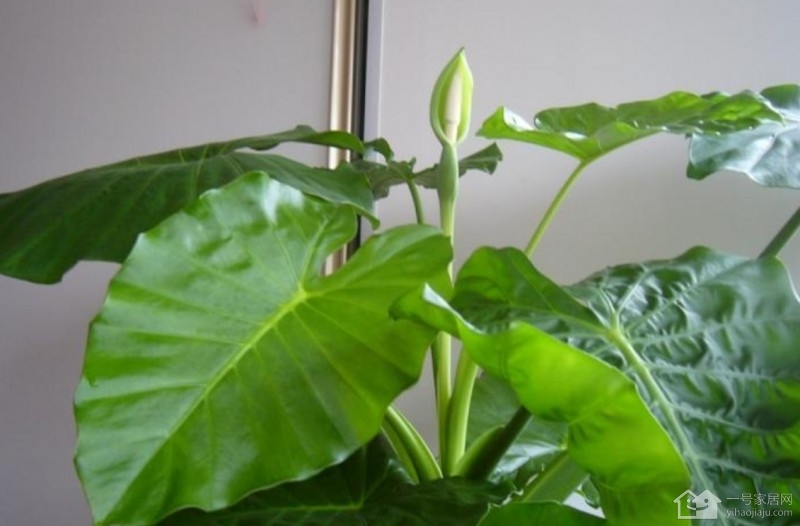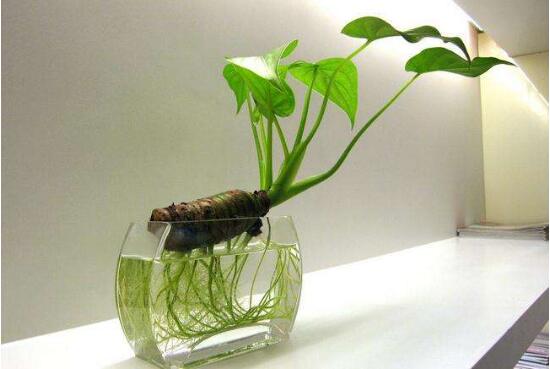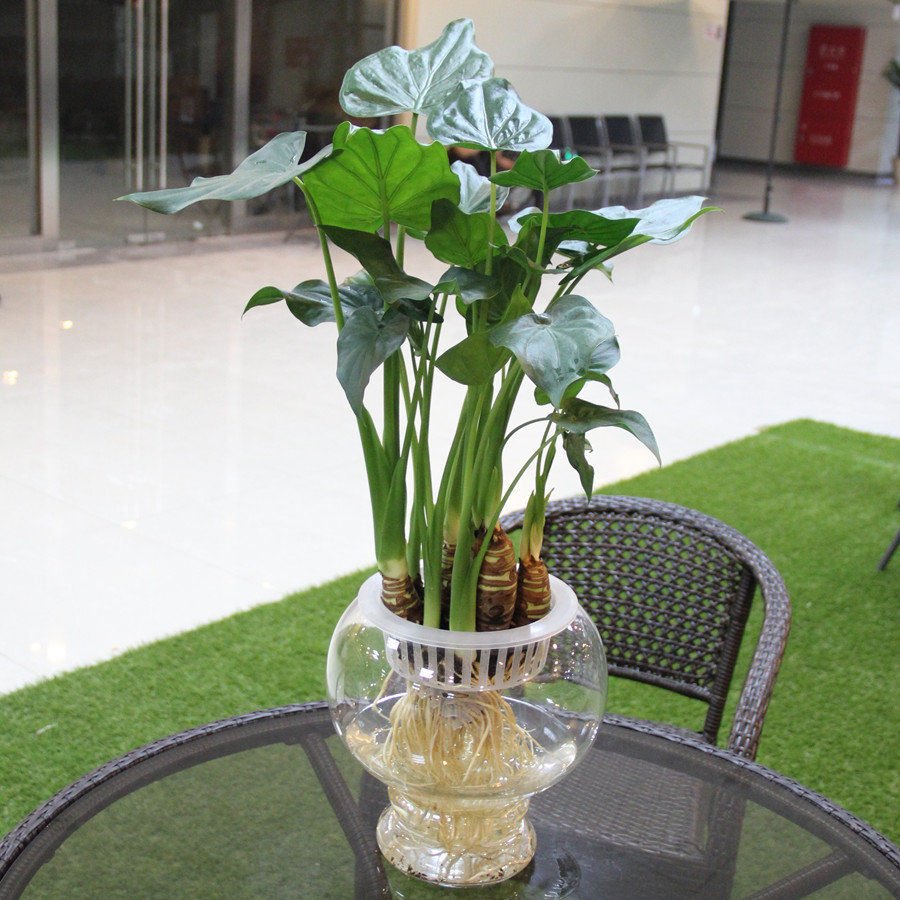What are the indoor maintenance methods of Dishui Guanyin?
Dishui Guanyin, also known as sea taro, is a perennial herb of the Araceae family. Because its flowers are very similar to Guanyin Bodhisattva, and because its leaves drip at the edges when the humidity is high, it is called dripping Guanyin. Generally speaking, the sap of Araceae plants is poisonous, but as long as it is kept at a proper distance, it is not dangerous not to contain branches, leaves and fruits in the mouth, and it can also absorb indoor toxic substances.
The leaves of Dishui Guanyin are round, with different plant types of different sizes, and their cultivation forms are different, including large potted plants more than 2 meters high and ordinary small potted plants, which can be made into bonsai and hydroponic culture. Although the cultivation forms are different, there is no big difference in maintenance methods.
(1) soil
Dripping Guanyin is not strict with the soil and grows best in fertile and moist acidic soil. River soil can also be directly used to cultivate dripping Guanyin.
(2) humidity and light
Indoor maintenance dripping Guanyin, to maintain a high air humidity is the key, to often spray to the leaves, dry air or lack of soil water is easy to cause leaf wilting. Dripping Guanyin likes yin and cannot accept the hot sun, otherwise the leaves will scorch. Dripping Guanyin has been placed in living rooms and bedrooms for a long time. If there is not enough light, the leaves will become smaller and yellow, and the petiole will also become slender. At this time, you should appropriately increase the light or regularly go to the balcony to receive light.
(3) temperature
Dishui Guanyin prefers warm and humid environment, and its cold resistance is poor. The overwintering temperature should be above 10 ℃. For large plants with roots, if the leaves are frostbitten in winter, the petiole can be gently peeled off and new leaves will still sprout in the following spring.
(4) Fertilizer and water management
April to October is the growing season of dripping Guanyin, liquid fertilizer must be applied once a week, especially the amount of nitrogen fertilizer should be increased. The watering principle of dripping Guanyin in the growing season is "rather wet than dry", while in winter dormancy, watering should be controlled as far as possible to improve cold resistance.
The indoor maintenance method of dripping Guanyin, also known as sea taro, belongs to the perennial herb of Araceae. Because its flowers are very similar to Guanyin Bodhisattva, and because its leaves drip at the edges when the humidity is high, it is called dripping Guanyin.
The leaves of Dishui Guanyin are round, with different plant types of different sizes, and their cultivation forms are different, including large potted plants more than 2 meters high and ordinary small potted plants, which can be made into bonsai and hydroponic culture.
1. Soil
Dripping Guanyin is not strict with the soil and grows best in fertile and moist acidic soil. River soil can also be directly used to cultivate dripping Guanyin.
Humidity and light
Indoor maintenance dripping Guanyin, to maintain a high air humidity is the key, to often spray to the leaves, dry air or lack of soil water is easy to cause leaf wilting. Dripping Guanyin likes yin and cannot accept the hot sun, otherwise the leaves will scorch. Dripping Guanyin has been placed in living rooms and bedrooms for a long time. If there is not enough light, the leaves will become smaller and yellow, and the petiole will also become slender. At this time, you should appropriately increase the light or regularly go to the balcony to receive light.
Third, temperature
Dishui Guanyin prefers warm and humid environment, and its cold resistance is poor. The overwintering temperature should be above 10 ℃. For large plants with roots, if the leaves are frostbitten in winter, the petiole can be gently peeled off and new leaves will still sprout in the following spring.
IV. Fertilizer and water management
April to October is the growing season of dripping Guanyin, liquid fertilizer must be applied once a week, especially the amount of nitrogen fertilizer should be increased. In this way, the leaves can grow bigger, otherwise the leaves are small and yellow. It should be watered more from April to November and grow rapidly when the temperature is above 25 ℃. The watering principle of dripping Guanyin in the growing season is "rather wet than dry", while in winter dormancy, watering should be controlled as far as possible to improve cold resistance.
What are the breeding methods of dripping Guanyin?
Dishui Guanyin, Araceae, Amorphophallus, also known as Di Shuilian, bergamot and so on, is one of the most common family cultured plants, hence its name because of its flowers like Guanyin. Dishui Guanyin is really a good choice to purify the air indoors. Dishui Guanyin is a very common domestic green potted plant, but because it is a tropical plant, it generally does not blossom in the north. So what are the breeding methods of dripping Guanyin? How to raise Guanyin in dripping water?

Dishui Guanyin Culture Technology
1. Basic information of Dishui Guanyin
Dishui Guanyin is a trade name, also known as "Dishui lotus" and bergamot lotus. Other common names include trace taro, wolf venom (Guangdong), wild taro, mountain taro, big root taro, big worm taro, celestial taro, Tianmeng, and so on. Taiwan's calla lotus refers to sea taro. This plant is a perennial evergreen herb of the genus Alocasia-Alocasiamacrorrhizos of Araceae, and has medicinal value. On that day, when the temperature is warm and humid and the soil water content is high, water will drip down from the leaf tip or the edge of the leaf, and the flower is a fleshy spike, with a large green spawn, which develops into a boat, just like the statue of Guanyin, so it is called dripping Guanyin in many places. It is native to the subtropics and likes warm, humid and semi-shady environment. It is not cold-tolerant. It is potted in the north of the Yangtze River valley in China. It is moved indoors before winter, and can grow in the open field in the south. The bulbs and leaves can be used as medicine, but they are poisonous. The entrance of its leaf juice will be poisoned.
Second, the ecological habits of Dishui Guanyin
Dishui Guanyin is a plant that likes a warm, humid and slightly shaded environment, but it is required to ensure adequate sunlight during its flowering period, otherwise his bud will be green, thus affecting its quality. For dripping Guanyin, it is necessary to ensure 5 hours of light every day, otherwise its petiole will elongate and affect its ornamental value. Dishui Guanyin is not very cold-resistant, and it is moved to the greenhouse in mid-October every year. In summer, under the condition of shade, it is often sprayed with water to cool and moisturize. Dishui Guanyin is naturally fond of moist and fertile soil, which is what farmers often call "big fat and big water", so it has to be watered a small number of times during its growth. Dishui Guanyin is a very common domesticated green potted plant at present, because it is a tropical plant, so it generally does not bloom in the north. But if the temperature and humidity at home are suitable, it may blossom. Although the requirement of dripping Guanyin on soil is not high, it is the most ideal planting method if it grows best in sandy loam or humus loam with good drainage and organic matter.
Third, Dishui Guanyin culture method
1. The culture temperature suitable for dripping Guanyin: 20Mel 25 ℃ is the most suitable culture temperature for dripping Guanyin. When the room temperature is lower than 18 degrees, it will cause Dishui Guanyin to enter the dormant period and stop growing. Dishui Guanyin likes a warm, humid and semi-overcast environment. In the process of breeding, we should especially grasp the changes of the seasons. Especially now that we are stepping into summer, we should pay special attention to putting dripping Guanyin in a semi-overcast ventilated place, and we need to spray water on the leaves of dripping Guanyin many times to maintain the humidity of the air. Avoid abnormal dripping Guanyin caused by high temperature. The cold resistance of Dishui Guanyin is not strong. According to the temperature difference between the north and the south, Dishui Guanyin needs to be moved indoors in autumn and winter.
2. How to fertilize Dishui Guanyin: the fertilization cycle of Dishui Guanyin is once a month. Dishui Guanyin must be given every 2 weeks. And need to humidify the basin soil of Dishui Guanyin. Fertilization requirements: it needs to be assisted by nitrogen fertilizer mixed with thin liquid fertilizer such as phosphorus and potash fertilizer. When topdressing, avoid pouring fertilizing water on the leaf sheath will cause dripping Guanyin rot. If you want to drop water, the leaves of Guanyin are large and green, which can be achieved by applying some ferrous sulfate. If you want dripping Guanyin to look beautiful, it is necessary to avoid lack of fat. once there is a lack of fertilizer, the stem of dripping Guanyin will be dry and bald. Usually see the dripping Guanyin is big and small, if you want to make the dripping Guanyin culture small and beautiful, such as 40cm when the seedlings grow to the height you want, spray 2% paclobutrazol solution through the whole plant, in the later growth process of dripping Guanyin, you will find that the growth height of Dishui Guanyin will not be higher than 40cm. If dripping Guanyin continues to grow, you can spray the whole plant again. Generally, the effect of controlling height can be achieved by spraying once in half a year.
3, pest control, dripping Guanyin disease reaction on the leaves, there are generally two kinds, one is leaf spot, the other is anthracnose. Leaf spot disease can be sprayed with chlorothalonil or carbendazim 800 times in a row for 3 times, every 7 days. Anthracnose needs to be sprayed with 75% methyl topiramate 500 times, once every 7 days, 2 Murray 3 times in a row, basically controllable. Because Dishui Guanyin is an ornamental plant, once the leaves get sick, it will inevitably affect its ornamental effect, so we should give priority to prevention.
Reaction on the stem, there is a Fusarium wilt, caused by bacterial infection, this disease is not easy to detect at first, once found, it will be very serious. If it is found that the stem is crooked to one side, or there is wilting, it must have given birth to Fusarium wilt, and the disease can be removed with a knife. The boundary between the disease and the non-disease is very clear, and it can be broken off by hand. If the diseased area is less than 1/3 of the stem, you can apply a layer of chlorothalonil solution to the non-diseased area and keep it dry. Apply it again every 10 days, and you can basically recover after 20 days.
The most serious pest in Dishui Guanyin is the mite, commonly known as the red spider. Red spiders are generally born on the back of leaves, it not only absorbs the nutrition of leaves, but also spreads various viruses, seriously affecting the growth of plants, so it must be checked frequently and treated immediately once found. It can be treated with mifengqing, Saomijing, imidacloprid and other drugs.
4. the lighting problem of dripping Guanyin: for plants that like semi-shade, direct sunlight is the most taboo. When the farmed dripping Guanyin leaves droop, it may be the reason for the lack of fertilizer. At this time, we need to add some liquid fertilizer to Dishui Guanyin. When Dishui Avalokitesvara enters its flowering period, it is necessary to make sure that you have 3Murray for 5 hours every day. Otherwise, the bud will be greenish, the petiole will be elongated, and the appearance will be affected.
The above is the relevant introduction of this article, I believe you have a simple understanding of this after reading it, if necessary, you can continue to pay attention to the No. 1 home network to learn more information.
- Prev

How to cultivate Dishui Guanyin
Dishui Guanyin, also known as Liriodendron mandshurica and Stellera mandshurica, is a perennial evergreen herb of the genus Araceae. It has sturdy stems, bright green leaves, chic posture, strong shade tolerance and easy to cultivate. After being cultivated as an indoor foliage plant, it was soon popularized and became a new favorite of foliage flowers.
- Next

How does Dishui Guanyin grow in water?
Dishui Guanyin, also known as sea taro and Guangdong wolf venom, is an evergreen herb of the Araceae family, originating in the south and southwest of China. The plant is large, up to 3 meters high, likes warm and humid environment, the suitable temperature for growth is 25-30 ℃, the best overwintering temperature is more than 10 ℃, and it can also withstand a low temperature of about 5 ℃.
Related
- Fuxing push coffee new agricultural production and marketing class: lack of small-scale processing plants
- Jujube rice field leisure farm deep ploughing Yilan for five years to create a space for organic food and play
- Nongyu Farm-A trial of organic papaya for brave women with advanced technology
- Four points for attention in the prevention and control of diseases and insect pests of edible fungi
- How to add nutrient solution to Edible Fungi
- Is there any good way to control edible fungus mites?
- Open Inoculation Technology of Edible Fungi
- Is there any clever way to use fertilizer for edible fungus in winter?
- What agents are used to kill the pathogens of edible fungi in the mushroom shed?
- Rapid drying of Edible Fungi

